 World’s navies (1863 to today)
World’s navies (1863 to today)As these lines are written, the world would remember medical personal and nurses involved in the present COVID19 pandemic. But ships dedicated to the care of the wounded existed almost since the red cross was invented: By Swiss businessman Henri Dunant, horrified to see casualties at the battle of Solférino in 1859. The movement was founded in 1863. Now headed by an international committee based in Geneva its symbol was based on the national flag, just with colors inverted. Now the red cross and red crescent (for obvious reasons in the Muslim world) is a movement strong of 97 million volunteers, members and staff worldwide. They used ships, as well, but the Navy grew its own class of specialized vessel over time as well: The Hospital Ships.
Here are the questions this article would pay attention to. How these ships worked, their histories, countries that used them, conflicts…
Origins of Hospital ships
These vessels are probably much older than most thinks.
Antiquity: In the ancient world, an Athenian Navy ship was named Therapia (used during the long Peloponesian war), and the Roman Navy had another named Aesculapius, both obvious medical names, which indicated a possible use for that purpose.
Timeline of hospital ships
- 1608: The Royal Navy fleet was accompanied by a ship named Goodwill, registered in effect as an hospital ship. She was rather used to carry wounded men to the nearest port than to care for them.
- 1683: RN ships Unity and Welcome are used to evacuate and treat sick troops on the way.
- 1650-1700: Formal Hospital ships are introduced in the Royal Navy, with a permanent staff made of a surgeon and four surgeon’s mates. Bandages, soap, needles and bedpans were carried, clean rugs and clothes provided, but the food quality was atrocious and these ships tended to care for the sick more than the wounded, some requisitioned as floating larazetos, for quarantine. In 1798 two dedicated ships were even built. They were converted hulks of 44 gun ships moored in Halstow Creek in Kent.
- 1703: New regulations imposed a surgeon, six landsmen to act surgical assistants, and four washerwomen on each ship and later to be assisted with five designated male nurses.
- 1798: After the battle of Trafalgar the famous HMS Victory was converted as a makeshift hospital ships, to care for French and Spanish wounded captives.
- 1821: The Seamen’s Hospital Society was given three successive hospital ships, the HMS Grampus, HMS Dreadnought and HMS Caledonia.
- 1854: The Crimean war was the firsy large-scale use of hospital ships. Indeed more men died of illness rather than in combat, on all sides. In total 15,000 wounded troops would be carried to the large hospital at Scutari by a fleet of hospital ships.
- 1860: During the expedition in China, two dedicated, puspose-built steamships HMS Melbourne and HMS Mauritius are used during the expedition to China.
- 1864: During the American civil war, the USS Red Rover carried and treated wounded from all sides.
- 1877: A British Red cross steamship is sent to care for the victims of the Russo-Turkish war. This vessel was well staffed and carried a surgery room, chloroform, other anaesthetics, and carbolic acid.
- 1882: During the invasion of Egypt, at least two British hospital ships care for the wounded.
- 1898: During the Spanish-American war, again, hospital ships are used on both sides.
- 1905: The Russians (Russo-Japanese war) used the converted Hospital ship Orel. The paradox was that after regulation, the later was illuminated and revealed to the Japanese the position of the Russian fleet at Tsushima. The same year in UK, the Royal Hamadryad Seamen’s Hospital is funded. Many other will follow.
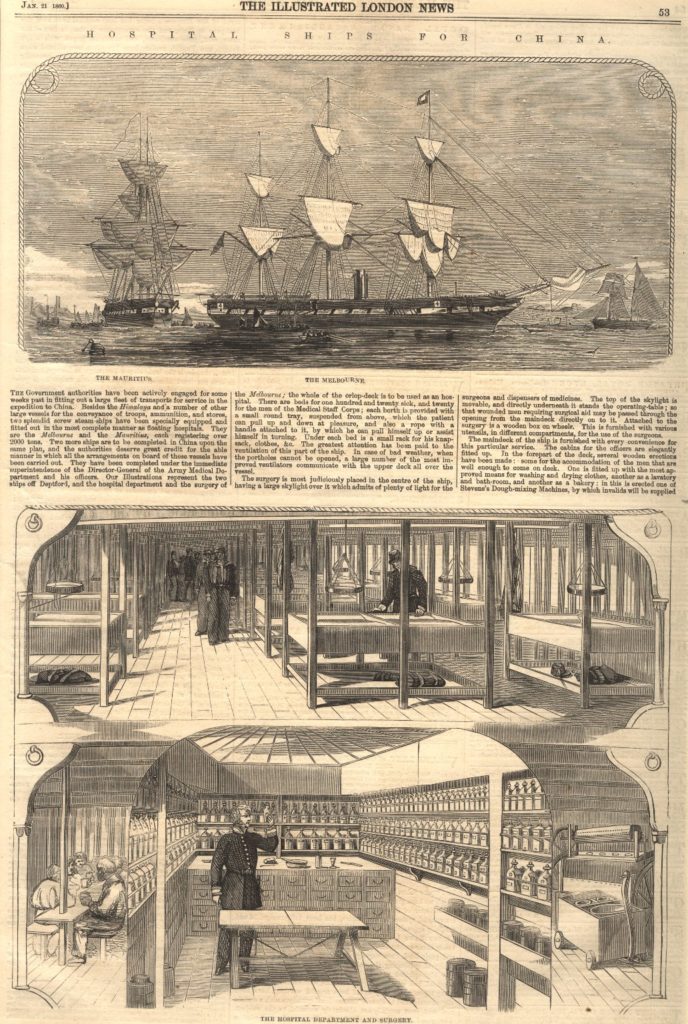
HMS Melbourne, second Opium war
The question of naval quarantine
Since the great black plague has been carried in Europe by a boat from the Byzantine Empire, ports are known centers and starting points of infection. Globalization was an ancient concept. The quarantine was invented and applied at first to avoid contamination of ports if an arriving ship declared illness cases, and as a general practice of the time, a 40 days confinement of the crew, even if the ship was anchored in the harbor area; Hence the “quarantine” from the French “quarante”, forty (days).
The term was also used as a means of blocus, applied for example in the case of Cuba during the missile crisis in 1962.
There was no more treatment on board than on any regular ship, so this was only a safety measure, not a conversion or change in use.
Famous Hospital ships in WW1
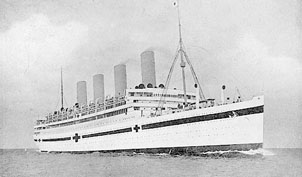 During the first world war, a legion of hospital ships, converted from liners and packet boats, big and small, are used on many fronts, but in particular in the Mediterranean, Black sea and the Dardanelles. Prestigious and massive ships of the transatlantic lines were used, such as the imposing RMS Aquitania and HMHS Britannic. The Royal Navy alone had 77 Hospital ships on service by 1918. They usually had the task of carrying the wounded to large field hospitals far from the front, but had the medical staff to care for the wounded during the trip.
During the first world war, a legion of hospital ships, converted from liners and packet boats, big and small, are used on many fronts, but in particular in the Mediterranean, Black sea and the Dardanelles. Prestigious and massive ships of the transatlantic lines were used, such as the imposing RMS Aquitania and HMHS Britannic. The Royal Navy alone had 77 Hospital ships on service by 1918. They usually had the task of carrying the wounded to large field hospitals far from the front, but had the medical staff to care for the wounded during the trip.
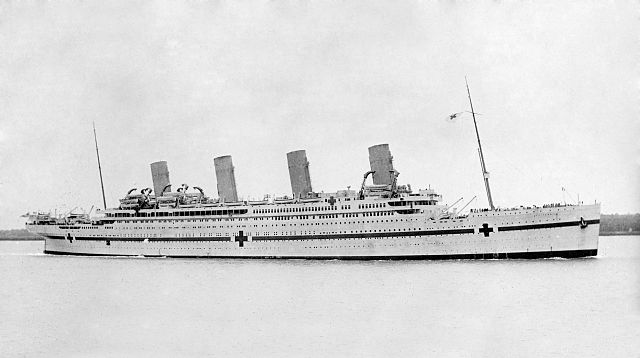
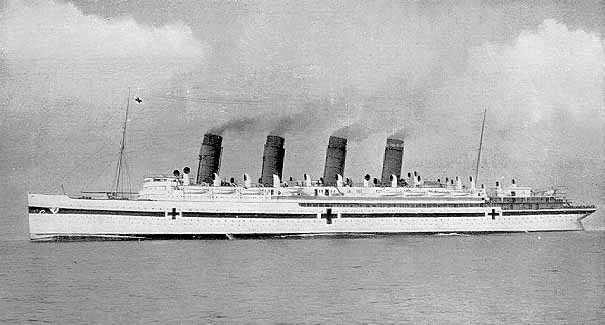
HMHS Britannic and Mauretania
Regulation and warfare
Hospital Ships, to be spared by all belligerents needed to comply with a set of largely accepted international rules, which added to the existing conventions of La Haye and Geneva. The original document was signed by powers of the time in 1907, called the Hague Convention X.
As follows, there were the conditions to stay out of harm for an hospital ship:
-Ship must be clearly marked and lighted as a hospital ship
-Ship should give medical assistance to wounded personnel of all nationalities
-Ship must not be used for any military purpose
-Ship must not interfere with or hamper enemy combatant vessels
-Belligerents, as designated by the Hague Convention, can search any hospital ship to investigate violations of the above restrictions
-Belligerents will establish the location of a hospital ship
U-Boat warfare and Hospital Ships
When WW1 broke out, the rules of war clearly forbade any shelling or attack on field hospitals, and this was true for hospital ships too. According to the Hague Convention X of 1907, hospital ships of that era to be spared by enemy attacks, needed to give medical assistance to all belligerents, having strictly no weaponry nor military crew on board (outside the wounded), never interfere with the operations of other vessels and free to be inspected at will if violating one of the above.
Authorities clearly showed the ship’s purpose by a visible color and symbolic code:
-A white hull as it needed to be well visible at sea (and not grey or camouflaged)
-Large, red crosses painted on the hull, as least at two places either side of the hull, in order to be spotted by any ship from any angle from afar.
Often crosses were separated by long red stripes.
At the end of WW1 as planes were commonplaces, the decks and roofs were also clearly marked y red crosses on a white background.
In case also, the ship’s denomination, visible at the poop and bow integrated the letter “H”, such as HMHS or USHS.
Despite of all this, 26 hospital ships were sunk during the war.
The first, HMHS Anglia, was torpedoed in November 1915. She was followed by HMHS Asturias, Huntley, Dover Castle, Donegal, Galeka, Glenart castle, Gloucester castle, Lanfranc, Rewa, Rohilla, Salta, but also the Australian Warilda, the Russian Vpered and Portugal, the Dutch Konigin Regentes, the Canadian Letitia and Llandovery Castle, and the Greek SS India.
The fourth condition seen above left the German high command, when launching its unrestricted submarine warfare, to consider allied hospital ships as violating the Hague Convention. U-Boats were given free range with them. They also considered that these ships carried able-bodied soldiers in the mix and therefore should be considered partly as troop transports.
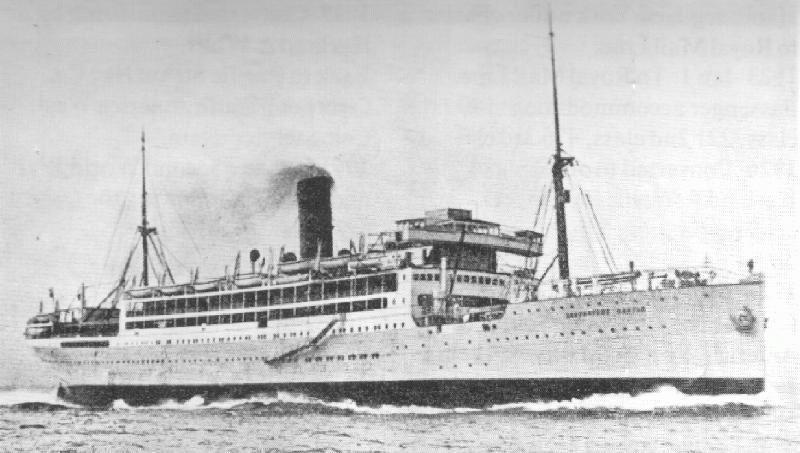
HMCHS Llandovery castle. War crimes were not proper to nazi fanatics in WW2: Kapitan Helmut Patzig and his lieutenants were hunted after the war for war crimes, after perpetrating the massacre of the survivors of the hospital ship they just torpedoed. This was gift for allied propaganda at the time.
By far, the most spectacular hospital ship loss was HMHS Britannic, sister of the Olympic and famous Titanic. She likely hit a mine on November 21, 1916 but sank slowly as to only claim 30 , whereas the rest of the crew managed to evacuate and be rescued. This was the opposite of the dreadful sinking of the Lusitania.
However what really triggered opinions further against the German Empire was the scandal of the sinking of HMHS Llandovery Castle. Torpedoed by U-boat U-86 on June 27, 1918, survivors were gunned down with gun, machine guns and rifle fire after the submarine emerged. Only 24 were rescued. Captain Lieutenant Helmut Patzig escape charges of war crimes after the war by taking refuge in Dantzig. His two lieutenants also escaped after their conviction.
Nevertheless, the German hospital ship Ophelia was seized by British naval forces (alleged to be a spy ship), whereas the Austro-Hungarian Baron Call was near-missed but Oceania and Tirol were sunk.
The British Navy during WW1 operated 92 Hospital ships. They were of the early non-specialized types, transport vessels with a personal of nurse to care for the wounded and limited equipment and could double as troopships. Thee also operated during the Russian civil war, the HMHS Braemar Castle, Garth Castle and Kalyan.
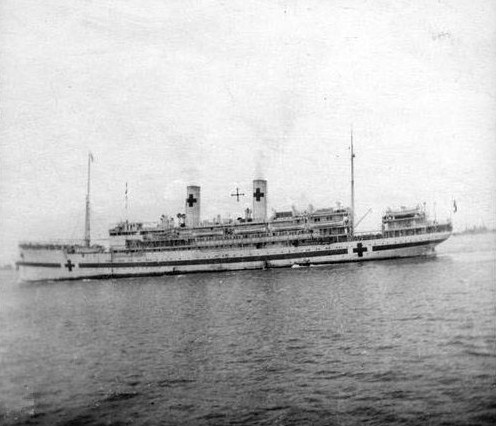
The French operated far less hospital ships. Mostly in the Mediterranean for external theatre of operations, around the Aegean, Greece and the Balkans. These were the requisitioned Sphinx, launched 1914, the Duguay-Trouin and Asie. During the interwar, the Sphinx served again as liner, and was requisitioned in 1939 and converted once more. She evacuated allied troops at Narvik after their brave showdown in late April 1940.
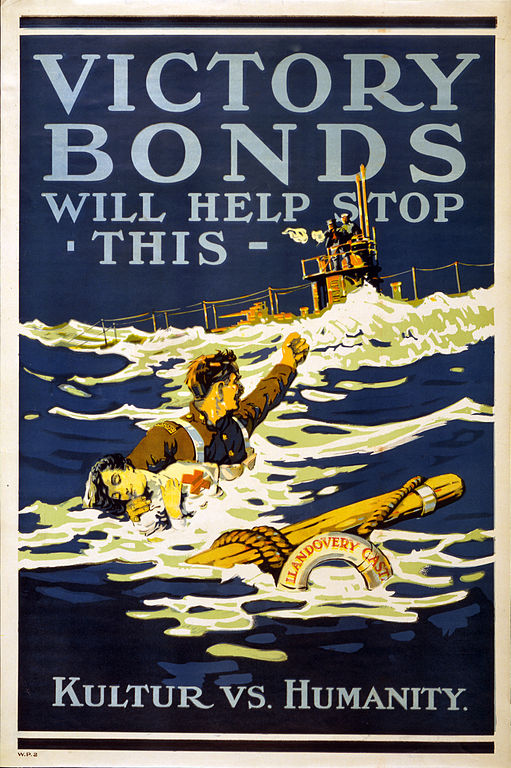
A gift for propaganda: The image of German submariners machine-gunning nurses in the Atlantic revolted the allied press. It was used as here to boost the war bonds campaign.
Hospital Ships in WW2
USN ww2 Hospital Ships
Of course during the interwar, Hospital ship activity dwindled back to proper navy dedicated vessels. All previously converted ships were rendered to their former use. The USN launched its first dedicated hospital ship in 1921: This was the USS Relief. She was followed by the USS Comfort, USS Hope, and USS Mercy (1944), essentially transport ships to hospital, whereas USS Relief was a proper floating hospital, provided with state-of-the-art equipment and staff.
She could be moored close to the operation area instead of just carrying the wounded to other areas. The USN deployed a dozen of dedicated hospital ships, but much more were converted. They were well served by a fleet of “evacuation ships” which were just reset troopships, escaping the Gevena Convention (they were not covered by it and could be targeted by the enemy). These were the USS Tryon (APH-1), USS Pinkney (APH-2), USS Rixey (APH-3) of the Tryon-class, and USS Haven (APH-112) and USS Tranquillity (APH-114).
Converted LSTH
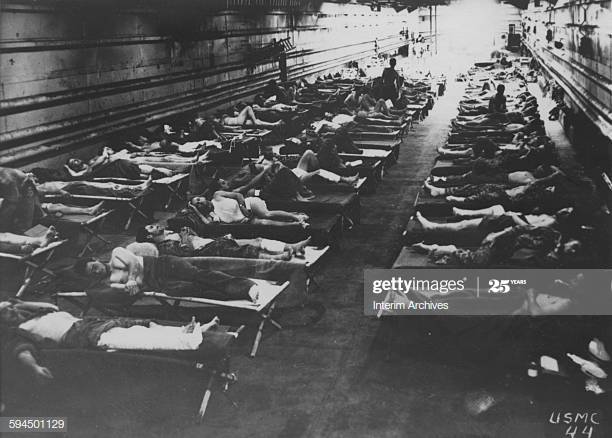
Landing Ship, Tank (Hospital) were a conversion not protected by the Geneva convention as they retained their armament. This appeared after the very first engagements, the roomy LSTs spontaneously served as makeshift hospitals. They offered a shelter to enemy fire thanks to their large, armoured holds, and plenty of supplies, water and accomodation for regular pharmacy mates, not surgeons and nurses. On D-Day alone, 41,035 wounded were evacuated to UK on approx. 150 LSTs, twice their troop capacity. The trend started in 1943, as Vice Admiral Daniel E. Barbey, USN, Commander 7th Amphibious Force during 1943, ordered the conversion of one LST to “first aid ship”.
The USS LST-464 was completely refitted at Sydney with modified tank deck for a fixed hospital facility, three storey, new water tight doors on port and starboard sides, a triage area, 78 hospital beds, full accommodations such as washrooms, toilets, increased galley, refrigerators, and complete surgical suite. Facilities were capable of performing radiology, pharmacy, laboratory, eye refractions, dental care. There was even a blood bank and stores for 25 tons of medical supplies. The medical staff comprised 6 physicians, one dentist and corpsmen. She was still not protected by the Geneva convention because of her LST appearance and despite the lack of armament and a big “464” painted on her hull amidships to be easily spotted. She became LST(H)-464 after the war.

In the latter part of the Pacific campaign, LSTs received surgical teams to treat unstable patients and thus were known as hospital LSTs. Nevertheless, they carried troops and landing them at the start of the operation, but soon after the team set up the well deck into an organized hospital, staffed with five physicians as well as 35 Pharmacist Mates. They served at Tarawa, Iwo Jima, Philippines, and Okinawa. This was still not really standard practice.
In preparation of Operation Olympic, the Navy decided to convert 36 LSTs as hospital ships from the start and to be redesignated LSTHs. They had facilities and a larger medical staff, in order to take care of the thousands of wounded awaited. This was planned for November 1945 and the war ended before. Three of these served in May 1946 during the Magic Carpet operation, while others repatriated troops home.
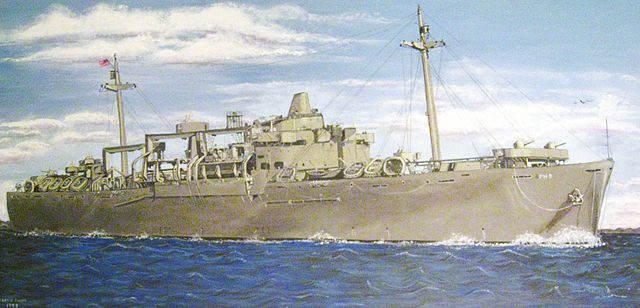
USS Rixey (APH-3) was an armed evacuation vessel (with one 5″/38 DP and twelve 40 mm guns AA – she won two battle stars). Not a true hospital ship as the medical staff was just her to care for the wounded during the time of their evacuation. In this guise, she had a capacity for 700 beds, but a troop capacity of 1,166 if needed.
British ww2 Hospital Ships
The British Navy during WW2 operated 41 Hospital ships. This was far less than in WW1, but by that time, progresses has been made in the military mobile medical units and field hospital were better equipped. Most of these hospital ships were requisitioned and setup for their new task, some sunk during the war. In all, 25 hospital ships were lost to axis or allied aviation, rarely other causes: Seven british HS were lost, one Australian, one Soviet (HS Armenia in the black sea, 1941), three Greek, one Norwegian and for the axis, four Japanese (sank by sub USS Queenfish), seven Italian, and two German.
Axis Hospital ships
Germany, Italy and Japan all operated Hospital ships. Especially Japan, which area of operation was mostly accessible by sea and of a very large span.
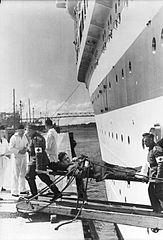 German Hospital ships such as the Wilhelm Gustloff (left) were called Lazarettschiff. These were requisitioned and converted vessels, also used as troopships. The latter was infamously sunk by Soviet submarine S-13 on 30 January 1945. The act was condemned postwar, as the Gustloff was jam-packed mainly with German civilians fleeing Soviet advance in Eastern Prussia, and wounded Wehrmacht infantry, the Soviet arguing she was carrying troops as well. This would remain the worst human tragedy at sea, as 9,400 people drawn, far worse than any other maritime disaster in history so far.
German Hospital ships such as the Wilhelm Gustloff (left) were called Lazarettschiff. These were requisitioned and converted vessels, also used as troopships. The latter was infamously sunk by Soviet submarine S-13 on 30 January 1945. The act was condemned postwar, as the Gustloff was jam-packed mainly with German civilians fleeing Soviet advance in Eastern Prussia, and wounded Wehrmacht infantry, the Soviet arguing she was carrying troops as well. This would remain the worst human tragedy at sea, as 9,400 people drawn, far worse than any other maritime disaster in history so far.
Means of proper identification
The need to use radio communications to advertise and identify medical transport became a vital one, as most were sunk by air attacks. In addition to 45 hospital ships, 4 ships chartered by the International Committee of the Red Cross (ICRC) were also sunk or damaged. Some used the international distress frequencies of 500 kHz and 1 650 kHz (ex 2 182 kHz) but attacking planes could not receive it. Therefore from 1944, hospital ships (as well as neutral vessels) sailing in the Mediterranean sent a message every four hours on the international distress call frequency in Morse at 500 kHz. In the Atlantic, this was once a day. This, this could be caught up by any belligerent.
Hospital ships in the cold war:
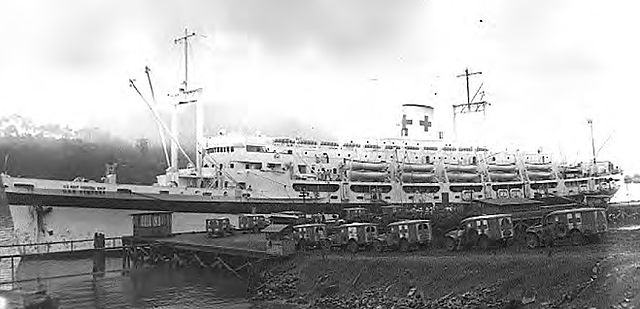
USS Comfort (AH-6) at Hollandia, 1945
The Korean war saw the use of the three sister-ship USS Comfort, USS Hope, and USS Mercy, ordered in 1943 and completed in late 1944 to 1945 (AH-6 to AH-8), and were well used during the Pacific war, close to the fighting. They were attacked by the Japanese several time, a Kamikaze even crashing into the Comfort. They were active during the Korean war as well, an Vietnam. The Comfort class has been followed by the USS Bountiful (AH-9), USS Samaritan (AH-10), USS Refuge (AH-11), and the Haven class, commissioned at the end of WW2. A proper Hospital ship, during the cold war, she could deploy floating helipads (photo), allowing the standard Hiller helicopters made famous by the 1980s serie MASH, to carry two from the battleline directly at the hospital ship’s gate. Countless lives were preserved by this ingenious shortcut.
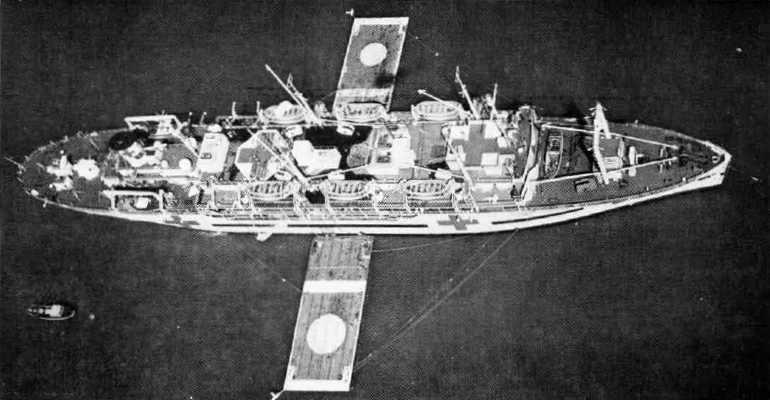
USS Haven with helipads.
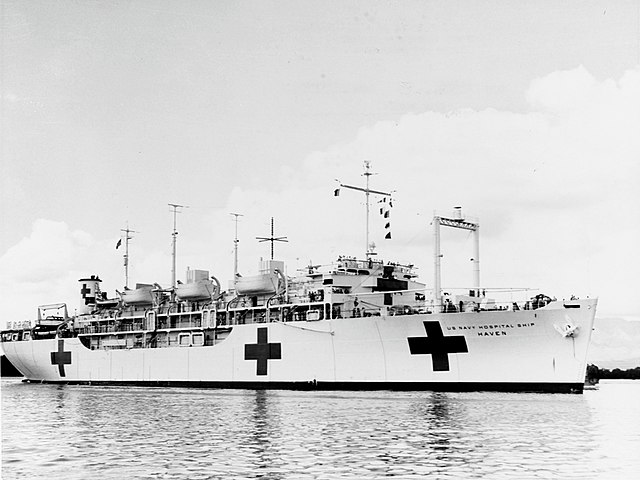
USS Haven, completed and commissioned in May 1945, in action in Korea.
USS Haven and the following ships, USS Benevolence (AH-13), USS Tranquillity (AH-14), USS Consolation (AH-15), USS Repose (AH-16), USS Sanctuary (AH-17) and USS Rescue (AH-18) were based on Type C4-class ships, much in demand by the civilian market and was sold in 1967 and converted as a cargo ship. They displaced 15,000 tonnes, for a top speed of 17.5 knots, a range 12,000 miles. The nursing staff includes 21 doctors and 270 nurses for a crew of 61 officers and 230 sailors. The were designed to support 802 injured, equipped with three operating rooms, radiology facilities, and laboratories. The crew was trained to disembark and setup in less than a day, a field hospital with 100 beds.
The British had the British royal yacht HMY Britannia, convertible in wartime as an hospital ships, but which also doubled as a refuge ships for the Royal Family, which would have been evacuated to the Scottish loch in case of nuclear war. During the Falklands war, the Royal Navy deployed four hospital ships, the HMS Hecla, Herald, Hydra and the liner SS Uganda. The Hecla class were designed as combined hydrographic and oceanographic survey ships and built on civilian standards.
During the Vietnam conflict USS Saginaw (LST-1188) carried a MUST (Medical Unit Self-contained Transportable). This was to allow the vessel to set up a complete hospital after unloading troops and provide in-close support hospital facilities in a combat area.
It should be noted that the German hospital ship “Helgoland,” treated civilians from both sides during this war as well.
Modernized identification means
In a combat zone, announcing and identifying a medical transport needed the person in charge of the ship to transmit specific emergency signals, three “PAN PAN” groups followed by the “MEDICAL” group by radio. “medical transport” was defined in the Geneva Conventions of 1949 and Additional Protocols. It covers any means of transport, by land, water or air, military or civilian permanent or temporary for the exclusive medical transport use, and under the direction of a competent authority of a belligerent or neutral country.
For these purposes of identification, signals must be sent on international distress frequencies such as:
-2 182 kHz, 156 800 MHz
-If failing to do so, on backup distress frequencies 4 125 kHz and 6,215 kHz
-The aeronautical emergency frequency 121,500 MHz
-The military frequency 243 MHz 12 (or any other frequency which can be used).
The commnunication must contain:
-Identification as medical transport
-Its Position
-The number and type of medical transport
-The planned route
-Estimated duration of the trip
-Planned departure and arrival times, as applicable;
-Ans specific informations such as the flight altitude, standby radio frequencies, languages, modes and radar codes.
Hospital ships today
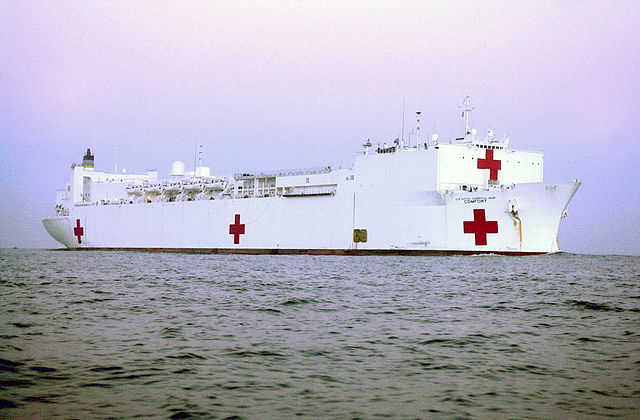
USNS Comfort – The largest hospital ship in service worldwide.
Others than Assault ships also have medical facilities, in the USN for example such as:
Gerald R. Ford-class aircraft carrier (full lab, pharmacy, operating room, 3-bed intensive care unit, 2-bed emergency room, and 41-bed hospital ward, 11 medical officers, 30 hospital corpsmen), all Nimitz-class aircraft carriers have a 53-bed hospital ward, three-bed ICU, and each is the hospital for the entire carrier strike group. Wasp-class amphibious assault ship (LHD), America-class amphibious assault ship (LHA), San Antonio-class amphibious transport dock (LPD), Harpers Ferry-class dock landing ship (LSD) and Whidbey Island-class dock landing ship (LSD) also had considerable facilities.
-The British Navy has no dedicated hospital ship. However the Auxiliary vessel HMS Argus, used to train air crews and be used as an helicopter carrier for various duties, amphibious assault or ASW warfare, also was well equipped with its medical facilities and can be used as an hospital ship with a quick set of modifications.
In fact most assault ships today integrates hospital facilities. The idea is that ships could provide quick emergency assistance in disaster zones, were all infrastructures are destroyed.
-The Chinese converted some of their Qiongsha-class cargo ships as hospital ship, as well as the multirole training vessel Shichang.
-In Europe, the French Mistral-class amphibious assault ship were given from the start an on board hospital facility NATO Echelon level-3. In Italy, both the Cavour aircraft carrier and logistic ship Etna are well provided, with NATO level-2 facilities, as well as the Spanish Juan Carlos I.
-The Argentinian icebreaker ARA Almirante Irízar, RAN Canberra-class landing helicopter dock, and the Japanese Izumo-class and Hyūga-class helicopter destroyers are also equipped.
Read more
//www.icrc.org/en
//www.thinkdefence.co.uk/a-uk-hospital-ship/
//www.mirror.co.uk/news/politics/uks-floating-hospital-ship-could-21715912
Video: History of hospital ships by the history guy

 Latest Facebook Entry -
Latest Facebook Entry -  X(Tweeter) Naval Encyclopedia's deck archive
X(Tweeter) Naval Encyclopedia's deck archive Instagram (@navalencyc)
Instagram (@navalencyc)





 Austrian Navy
Austrian Navy French Navy
French Navy Royal Navy
Royal Navy Armada Espanola
Armada Espanola K.u.K. Kriegsmarine
K.u.K. Kriegsmarine Dansk Marine
Dansk Marine Nautiko Hellenon
Nautiko Hellenon Koninklije Marine 1870
Koninklije Marine 1870 Marinha do Brasil
Marinha do Brasil Osmanlı Donanması
Osmanlı Donanması Marina Do Peru
Marina Do Peru Marinha do Portugal
Marinha do Portugal Regia Marina 1870
Regia Marina 1870 Nihhon Kaigun 1870
Nihhon Kaigun 1870 Preußische Marine 1870
Preußische Marine 1870 Russkiy Flot 1870
Russkiy Flot 1870 Svenska marinen
Svenska marinen Søværnet
Søværnet Union Navy
Union Navy Confederate Navy
Confederate Navy Armada de Argentina
Armada de Argentina Imperial Chinese Navy
Imperial Chinese Navy Marinha do Portugal
Marinha do Portugal Mexico
Mexico Kaiserliche Marine
Kaiserliche Marine 1898 US Navy
1898 US Navy Russkiy Flot
Russkiy Flot French Naval Aviation
French Naval Aviation Russian Naval Aviation
Russian Naval Aviation Sovietskiy Flot
Sovietskiy Flot Royal Canadian Navy
Royal Canadian Navy Royal Australian Navy
Royal Australian Navy RNZN Fleet
RNZN Fleet Chinese Navy 1937
Chinese Navy 1937 Kriegsmarine
Kriegsmarine Chilean Navy
Chilean Navy Danish Navy
Danish Navy Finnish Navy
Finnish Navy Hellenic Navy
Hellenic Navy Polish Navy
Polish Navy Romanian Navy
Romanian Navy Turkish Navy
Turkish Navy Royal Yugoslav Navy
Royal Yugoslav Navy Royal Thai Navy
Royal Thai Navy Minor Navies
Minor Navies Albania
Albania Austria
Austria Belgium
Belgium Columbia
Columbia Costa Rica
Costa Rica Cuba
Cuba Czechoslovakia
Czechoslovakia Dominican Republic
Dominican Republic Haiti
Haiti Hungary
Hungary Honduras
Honduras Estonia
Estonia Iceland
Iceland Eire
Eire Equador
Equador Iran
Iran Iraq
Iraq Latvia
Latvia Liberia
Liberia Lithuania
Lithuania Mandchukuo
Mandchukuo Morocco
Morocco Nicaragua
Nicaragua Persia
Persia San Salvador
San Salvador Sarawak
Sarawak Uruguay
Uruguay Venezuela
Venezuela Zanzibar
Zanzibar Warsaw Pact Navies
Warsaw Pact Navies Bulgaria
Bulgaria Hungary
Hungary

 Bundesmarine
Bundesmarine Dutch Navy
Dutch Navy Hellenic Navy
Hellenic Navy Marina Militare
Marina Militare Taiwanese Navy
Taiwanese Navy Chinese Navy
Chinese Navy Indian Navy
Indian Navy Indonesian Navy
Indonesian Navy JMSDF
JMSDF North Korean Navy
North Korean Navy Philippines Navy
Philippines Navy ROKN
ROKN IDF Navy
IDF Navy Royal New Zealand Navy
Royal New Zealand Navy Egyptian Navy
Egyptian Navy South African Navy
South African Navy

































 RN
RN
 Marine Nationale
Marine Nationale
 Soviet Navy
Soviet Navy
 dbodesign
dbodesign